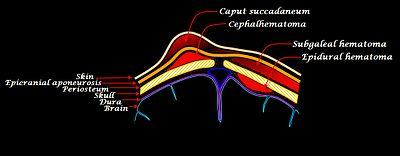| Cephalhematoma | |
|---|---|
| Other names | Cephalhematoma |
 | |
| Newborn scalp haematomata | |
| Specialty | Pediatrics |
A cephalohaematoma is a hemorrhage of blood between the skull and the periosteum of any age human, including a newborn baby secondary to rupture of blood vessels crossing the periosteum. Because the swelling is subperiosteal, its boundaries are limited by the individual bones, in contrast to a caput succedaneum.
Symptoms and signs
Swelling appears after 2-3 days after birth. If severe the child may develop jaundice, anemia or hypotension. In some cases it may be an indication of a linear skull fracture or be at risk of an infection leading to osteomyelitis or meningitis. The swelling of a cephalohematoma takes weeks to resolve as the blood clot is slowly absorbed from the periphery towards the centre. In time the swelling hardens (calcification) leaving a relatively softer centre so that it appears as a 'depressed fracture'. Cephalohematoma should be distinguished from another scalp bleeding called subgaleal hemorrhage (also called subaponeurotic hemorrhage), which is blood between the scalp and skull bone (above the periosteum) and is more extensive. It is more prone to complications, especially anemia and bruising.
Causes
The usual causes of a cephalohematoma are a prolonged second stage of labor or instrumental delivery, particularly forceps delivery. Ventouse application does not increase the incidence of cephalhematoma. Vitamin C deficiency has been reported to possibly be associated with development of cephalhematomas.
Management
Skull x-ray or CT scanning is used if neurological symptoms appear. These measurements are also used if concomitant depressed skull fracture is a possibility. Usual management is mainly observation. Phototherapy may be necessary if blood accumulation is significant leading to jaundice. Rarely, anaemia can develop needing blood transfusion. The presence of a bleeding disorder should be considered but is rare.
Cephalohematomas typically resolve spontaneously within weeks or months of birth, however calcification can occur in 3-5% of cases.[1] While aspiration to remove accumulated blood and prevent calcification has generally been recommended against due to risk of infection, modern surgical standards and antibiotics may make this concern unfounded, and needle aspiration can be considered a safe intervention for significantly-sized cephalohematomas that do not resolve spontaneously after one month.[1]
See also
References
- ^ a b Wong, Chin-Ho; Foo, Chee-Liam; Seow, Wan-Tiew (2006). "Calcified cephalohematoma: classification, indications for surgery and techniques". The Journal of Craniofacial Surgery. 17 (5): 970–979. doi:10.1097/01.scs.0000229552.82081.de. PMID 17003628.
External links
| Classification |
|---|